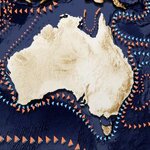Oceanography

Tiny probes packed with instrumentation have been turned loose in a laboratory in France. The marble-sized devices are an important step on the road to long-anticipated miniaturized machines known as smart dust (picture the artificial swarm in Michael Creighton's "Prey," only without the bloodlust). The small and simple machines are being developed to be released in large numbers to collect data about the motion of fluid systems such as ocean currents and atmospheric winds.
The two centimeter probes are on the large side for smart dust (typically, miniature machines must fill a volume of a…

Australia’s coral reefs, particularly the Great Barrier Reef, are national icons, of great economic, social, and aesthetic value. Tourism on the Great Barrier Reef alone contributes approximately $5 billion annually to the Australia’s economy. Income from recreational and commercial fishing on tropical reefs contributes a further $400 million annually. Consequently, science-based management of coral reefs is a national priority.
Globally, the welfare of 500 million people is closely linked to the goods and services provided by coral reef biodiversity.
The world’s oceans are becoming more…

In 2007, Arctic summer sea ice reached its lowest extent on record - nearly 25% less than the previous low set in 2005. At the end of each summer, the sea ice cover reaches its minimum extent and what is left is what is called the perennial ice cover which consists mainly of thick multi-year ice floes.
The area of the perennial ice has been steadily decreasing since the satellite record began in 1979, at a rate of about 10% per decade. But the 2007 minimum, reached on September 14, is far below the previous record made in 2005 and is about 38% lower than the climatological average. Such a…

A new study says that salt-saturated brine moving through floating sea ice follows “universal transport properties” and that this new understanding can help anticipate the effects of global warming on the polar oceans and the microbial communities existing there.
According to this new model, similar porous materials – including ice on other worlds, such as Jupiter’s icy ocean-covered moon Europa – should follow the same rules.
“It means that almost the exact same formulas describing how water flows through sedimentary rocks in the Earth's crust apply to brine flow in sea ice, even though the…

Australian scientists have identified the missing deep ocean pathway – or ‘supergyre’ – linking the three Southern Hemisphere ocean basins in research that will help them explain more accurately how the ocean governs global climate.
The new research confirms the current sweeping out of the Tasman Sea past Tasmania and towards the South Atlantic is a previously undetected component of the world climate system’s engine-room – the thermohaline circulation or ‘global conveyor belt’.
Wealth from Oceans Flagship scientist Ken Ridgway says the current, called the Tasman Outflow, occurs at an average…

More than a mile beneath the Atlantic’s surface, roughly halfway between New York and Portugal, seawater rushing through the narrow gullies of an underwater mountain range much as winds gust between a city’s tall buildings is generating one of the most turbulent areas ever observed in the deep ocean.
In fact, the turbulence packs an energy wallop equal to about five million watts -- comparable to output from a small nuclear reactor, according to a landmark study led by Florida State University researcher Louis St. Laurent.
The study -- an international collaboration of scientists from the…

Finding a decent, honest mate is challenging enough without the added problem of reduced visibility caused by human-induced changes to the aquatic environment.
Yet this is precisely the sort of dilemma female stickleback fish are facing in the Baltic Sea, according to a recent study published in the August issue of the American Naturalist by Dr. Bob Wong, an Australian researcher from Monash University, and his Scandinavian colleagues, Dr. Ulrika Candolin from the University of Uppsala and Dr. Kai Linstrom from the Åbo Akademi in Finland.
An increase in nutrient input in the Baltic is…

Technical advances over the past 50 years have allowed improved knowledge to be gained of the properties of sea water at great depths. Yet the first centimetres of the ocean remain its least well known part. They are difficult to sample and study owing to the mixing the oceanographic vessel provokes between this superficial layer and the deeper strata of water. Nevertheless, a whole ecosystem exists within this layer, carrying numerous living organisms like bacteria, zooplankton and larger animals such as flying fish, which feed and reproduce in it.
Research usually focuses rather on the…
Using echo-sounding equipment to create images and maps of areas below the ocean floor, researchers have begun to unravel a new story about the Antarctic Ice Sheet.
Images of areas below the Eastern Ross Sea, next to West Antarctica, provide evidence that the subcontinent was involved in the general growth of the Antarctic Ice Sheet as it formed many millions of years ago, according to scientists at the University of California, Santa Barbara. The National Science Foundation provided funding for the project.
Changes in Antarctica, an area that contains approximately 90 percent of the world’s…
Global climate change is causing Antarctic ice shelves to shrink and split apart, yielding thousands of free-drifting icebergs in the nearby Weddell Sea. According to a new study in this week’s journal Science these floating islands of ice – some as large as a dozen miles across – are having a major impact on the ecology of the ocean around them, serving as “hotspots” for ocean life, with thriving communities of seabirds above and a web of phytoplankton, krill, and fish below.
The icebergs hold trapped terrestrial material, which they release far out at sea as they melt. The researchers…